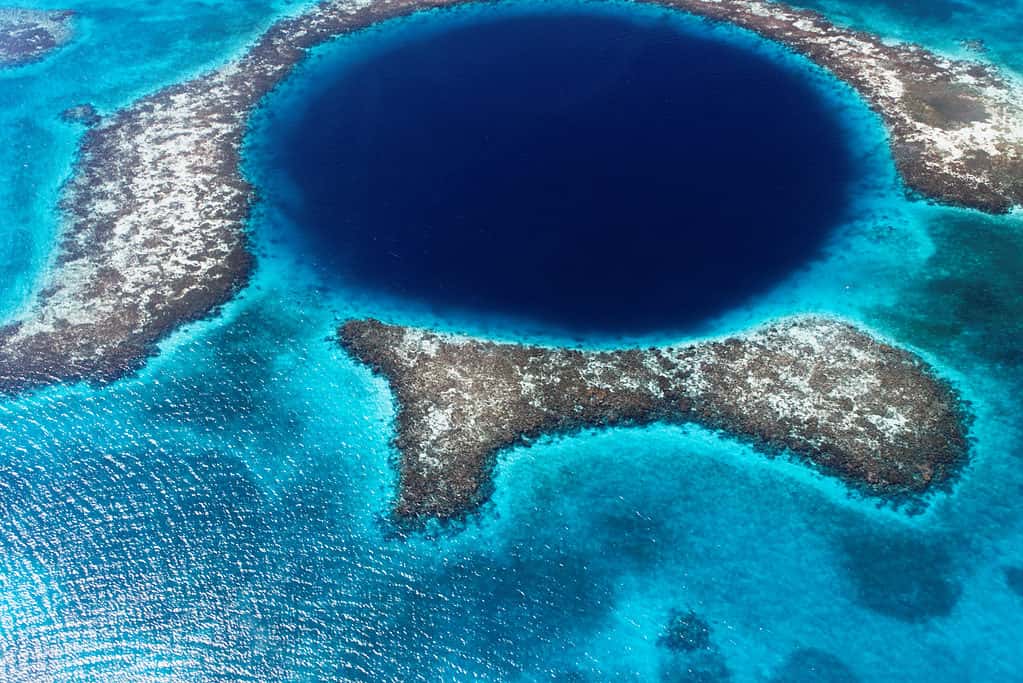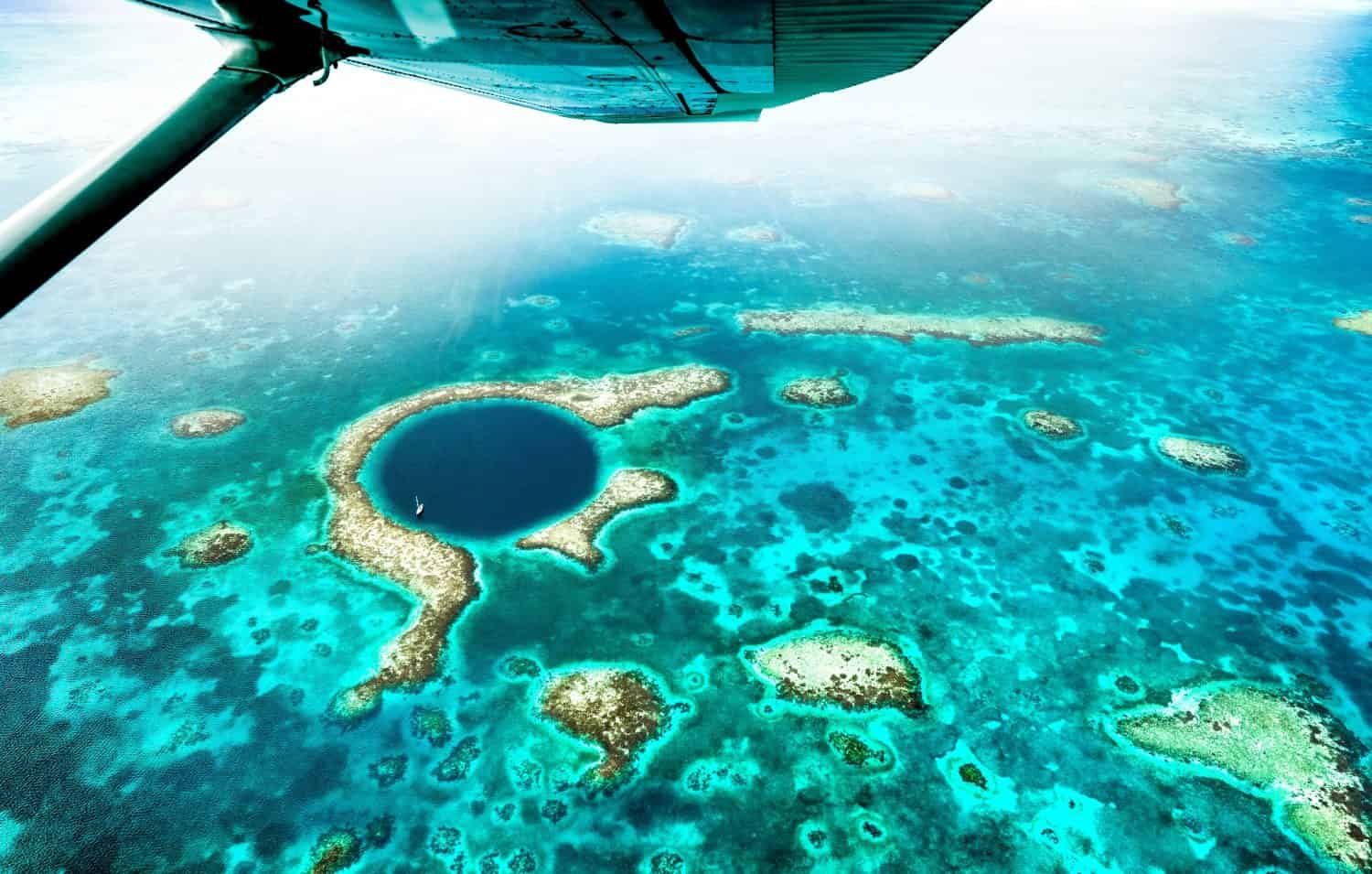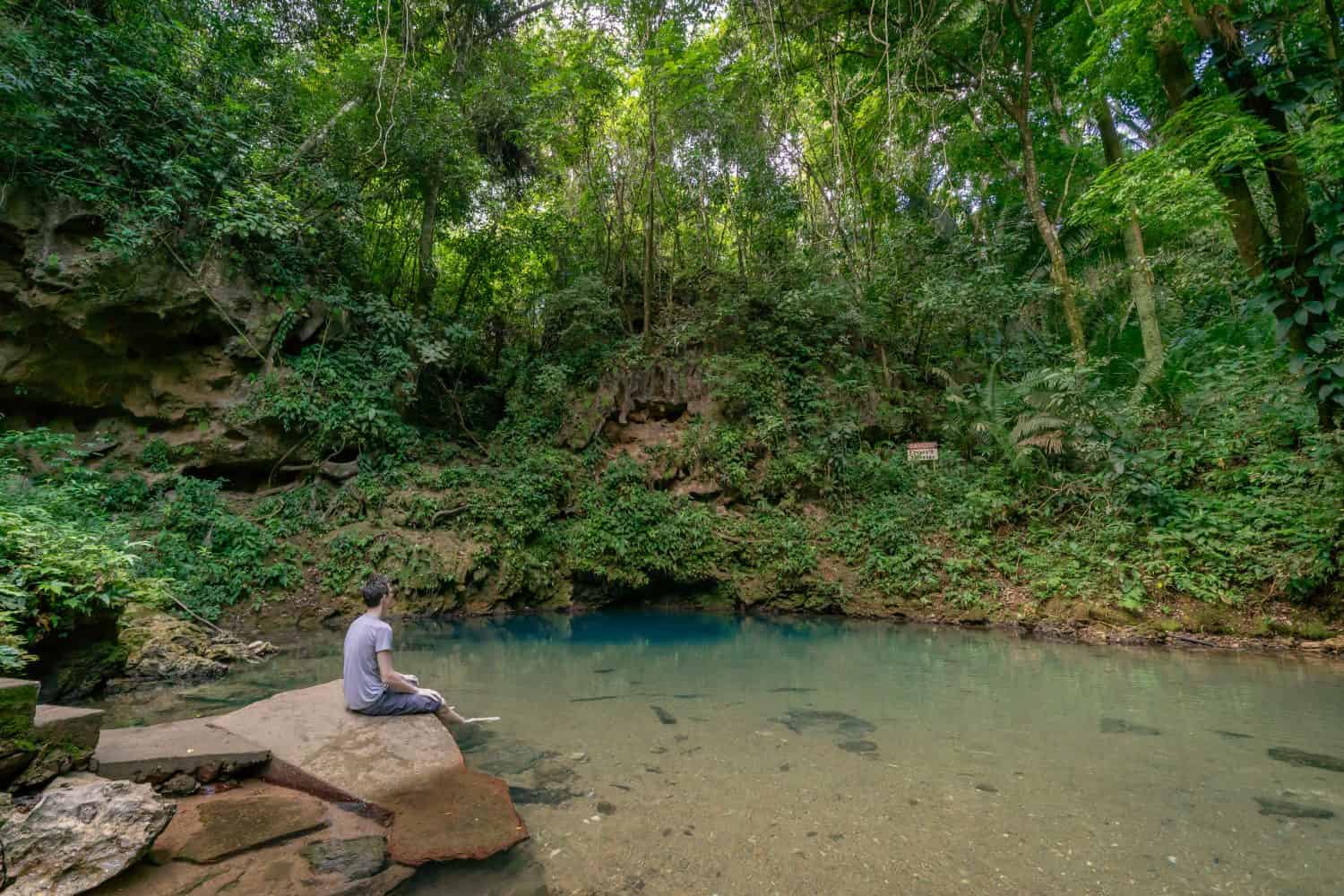Belize is a magical country on the eastern coast of Central America. To the north is Mexico, to the south and west is Guatemala, to the east is the Caribbean Ocean, and it shares a marine boundary to the southeast with Honduras. It’s an amazing destination for so many tourists annually. The mysteries of Belize are staggering, and most of them are tourist-friendly to a degree. Belize’s barrier reef is filled with flora and fauna and is a great diving adventure. In the dense rainforest jungle, you can find the Caracol Mayan Ruins, but it gets a bit more mysterious than even that! Approximately 50 miles off the beautiful coast of Belize is the Great Blue Hole. Let’s dive right into discussing the seen-from-space phenomenon.
The Creation of the Great Blue Hole

Belize’s Barrier Reef is filled with life and mysteries.
©V_E/Shutterstock.com
Scientists speculate that the Great Blue Hole formed around the time of the last ice age. This was a time when the Caribbean Sea level and all bodies of water on Earth were much lower than they are today. Inside the Great Blue Hole, you can find limestone stalagmites, stalactites, and other geological formations, just as you would in any ancient cave with the right amount of ingredients. Interesting, right? It gets better.
The Great Blue Hole is in the center of the Lighthouse Reef, which is abundant with flora and fauna and is much of its own world, along with its parent reef, the Belize Barrier Reef. The Hole is a dead zone; nothing can live where the sun cannot reach to create photosynthesis. It also lacks the appropriate oxygen circulation needed for living beings to inhabit. This intricate system of caverns formed before the global sea level rose to the heights that it is today. After it was filled with water and the formations collapsed inward, it became a massive underwater cave or sea hole.
The amazing and vast Belize Barrier Reef System is home to one of the most diverse and untouched marine ecosystems in the world. It has atolls, fringing, and barrier reefs within it. It is also part of a much larger reef spanning 600 miles along Mexico down to Honduras, making it the second largest in the world!
A Great Blue Hole Filled with Mystery

The Great Blue Hole of Belize is awe-inspiring, like the Bermuda Triangle.
©iStock.com/Lomingen
The Great Blue Hole is large at almost 1000 feet across and 410 feet deep. It’s also very dark which can add to the terror effect it can have on some people. If you happen to fly overhead, like in the photo above, you can see the clear turquoise water of the Caribbean turn to the darkest shade of blue-green found in nature before becoming black. The lighter aquamarine-colored water is caused by the vibrantly colored coral making up the Lighthouse Reef.
What has stumped scientists is how the formation occurred exactly since similar systems with further studied coral in the Pacific Ocean have atolls that formed differently. Most cave systems formed due to volcanic activity, but the Great Blue Hole did not. Instead, it formed from limestone-covered ridges that collapsed and formed “steps.” With further studies done, the Mayans likely lived on the atolls for a thousand or more years.
How Did The Great Blue Hole Become a Diver’s Dream?

Anorep 1, at the Oceanographic Museum in Monaco, was the first submarine used in 1966 by the celebrated marine explorer, Commander Jacques Cousteau.
©Dennis Jarvis from Halifax, Canada / CC BY-SA 2.0 – Original / License
The Mayans were the first known indigenous tribe to inhabit the atolls around the Great Blue Hole, though there were certainly earlier people to discover it existed. Charles Darwin wrote of Belize’s atolls and the Barrier Reef in 1886, writing they were “the richest and most remarkable coral reefs in the entire western Caribbean.”
Later, in 1971, the Great Blue Hole was made famous by Jacques Cousteau’s Calypso, which investigated the sea hole and its diving rating. He said the Great Blue Hole was one of the top ten diving sites in the world. On his show Undersea World of Jacques Cousteau, in the episode Secrets of the Sunken Caves, spurred the interest of fellow divers.
Since he was a renowned explorer and the “father of diving,” people took him seriously and believed his every word about the exquisiteness of the collapsed underwater caverns. After Cousteau’s investigation of the Great Blue Hole, diving took off in Belize, with travelers from all over the world coming to see it for themselves.
The Mysteries Continue to Escalate

The massive sea hole is perfectly round and symmetrical.
©View Apart/Shutterstock.com
The mysteries of the cave sea hole, the Great Blue Hole, continued to surprise researchers and divers. In 2018, Cousteau’s grandson Fabien, along with Sir Richard Branson and a team of explorers, made a trip to the sea hole to see it for themselves. Fabien followed in his grandfather’s footsteps as a diver and was there to take high-definition photographs and videos to share with the world.
While inside the sea hole, they saw the amazing stalagmites and some unexplained footprints whose origin remains unknown. The divers also came across two bodies of deceased divers and a graveyard of dead sea snails surrounded by plastic bottles and debris.
The Other Blue Hole

The other Blue Hole is located in St. Herman’s Blue Hole National Park and is part of the St. Herman’s cave system.
©Nickolas warner/Shutterstock.com
The other inland Blue Hole is a popular but remote swimming spot located 12 miles south of Belmopan in the center of Belize. It is not a sea hole like the Great Blue Hole but is a sinkhole. The St. Herman’s cave system is located in St. Herman’s Blue Hole National Park. The inland Blue Hole is actually a collapsed underground river, Caves Branch River that exposed the cave can be viewed for a bit over 150 feet then it once again becomes an underground cave, protected from the sun.
The Blue Hole itself is approximately 30 feet deep and is accessible down a small flight of stairs. It is a magical place, different from the Great Blue Hole but certainly incredible and worth checking out. It is located in the middle of a dense rainforest filled with animal and plant life. The jungle provides excellent air quality so be sure to breathe deeply. The Blue Hole’s water is a deep turquoise is perfect for a dip on a hot day. Since the pool is fed by the river running through the cave, the water is cool and refreshing, year-round. The rainforest location of the pool may generate the typical afternoon rain showers. However, it just adds to the experience.
Great Blue Hole Fun Facts
- The Great Blue Hole is toxic for most living creatures due to a large amount of hydrogen sulfide across the entire sea hole 300 feet below the surface, leaving roughly 110 feet at the bottom. The gas stopped oxygen from reaching lower than 300 feet. From that point down, the Great Blue Hole is without any life. The hydrogen sulfide is caused by organic matter such as plants and animals falling into the water over time. The decomposition created the hydrogen sulfide which made the Great Blue Hole uninhabitable. Anything that fell in, like conchs and hermit crabs, suffocated and died at the bottom.
- The Great Blue Hole will one day disappear. As the sand falls in daily, the sea hole is slowly becoming full.
- The name Great Blue Hole came from author and diver, Ned Middleton.
- The Great Blue Hole is the largest sea hole in the world.
- The two deceased divers found at the bottom of the hole were left there in the toxic black water as a sea burial, as directed by the authorities.
- If you want to dive in the Hole, all divers must be certified and experienced.
- The Discovery Channel ranked the Great Blue Hole as the most amazing place on Earth.
The photo featured at the top of this post is © iStock.com/hartmanc10
Thank you for reading! Have some feedback for us? Contact the AZ Animals editorial team.







